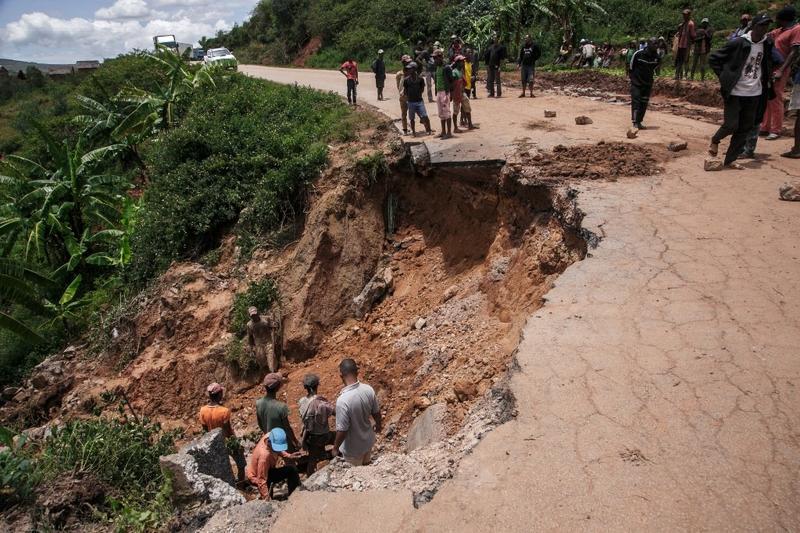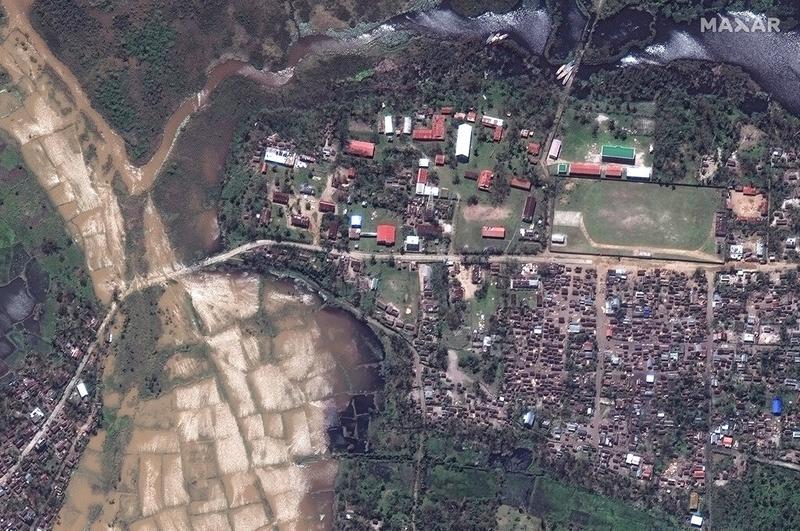 Residents look at the partially collapsed RN25 road in Ranomafana on Feb 7, 2022 following the passage of cyclone Batsirai. (RIJASOLO / AFP)
Residents look at the partially collapsed RN25 road in Ranomafana on Feb 7, 2022 following the passage of cyclone Batsirai. (RIJASOLO / AFP)
MANANJARY, Madagascar - Residents of a coastal town in Madagascar that was battered by Cyclone Batsirai over the weekend were left picking through the wreckage of their homes on Monday, collecting soaking wet clothing and anything else worth salvaging.
The cyclone also destroyed crops of rice, fruits and vegetables that were close to being harvested, worsening a food shortage in an area that was already struggling with the consequences of a severe drought, the United Nations' food aid agency said
The cyclone killed 21 people and displaced more than 60,000 after it slammed into the Indian Ocean island late on Saturday, knocking down houses and electricity lines along the southeastern coastline until it moved away late on Sunday.
It also destroyed crops of rice, fruits and vegetables that were close to being harvested, worsening a food shortage in an area that was already struggling with the consequences of a severe drought, the United Nations' food aid agency said.
In Mananjary, one of the worst affected towns, many houses had been completely flattened, while others still had walls standing but their roofs were missing. Debris and uprooted palm trees lying on their sides were everywhere.
"My house started to crack and we had to leave, all of a sudden it collapsed," said resident Sezie Kajy, who was picking up clothes from her ruined home.
She said she and other local people went to a school that had been designated as an evacuation centre, but the building's roof was blown off, so they were stuck in the open.
ALSO READ: Hunger looms in Madagascar with worst famine since 1981
 This AFP graphic dated Feb 3, 2022 shows the forecast path of Cyclone Batsirai which is heading towards Madagascar.
This AFP graphic dated Feb 3, 2022 shows the forecast path of Cyclone Batsirai which is heading towards Madagascar.
"We were in a bad situation, all the houses were destroyed. Water from the river and water from the sea rose, all the houses collapsed, we were really scared."
With a population of nearly 30 million, Madagascar had already been dealing with the aftermath of Cyclone Ana, which killed 55 people and displaced 130,000 just two weeks earlier
The state disaster relief agency said over 14,000 households, or more than 70,000 people in total, had seen their homes damaged or destroyed. Of those, about 62,000 were in shelters, while another 8,000 were either in the open or staying with relatives.
Crops destroyed
With a population of nearly 30 million, Madagascar had already been dealing with the aftermath of Cyclone Ana, which killed 55 people and displaced 130,000 just two weeks earlier.
Cyclone Batsirai struck a different part of the island, further south, where the population is facing a precarious situation in terms of food supplies because of a severe drought.
"The impact was severe and harsh and we are still counting casualties," said Pasqualina Di Sirio, country director for the United Nations' World Food Programme in Madagascar.
She said the destruction of rice crops so close to harvesting had made a bad situation worse and would be felt for six months. Fruit and vegetable patches had also been destroyed.
 This satellite image provided by Maxar Technologies shows close up of flooded roads, fields and main town Nosy Varika in Madagascar after Cyclone Batsirai on Feb 7, 2022. (SATELLITE IMAGE ©2022 MAXAR TECHNOLOGIES VIA AP)
This satellite image provided by Maxar Technologies shows close up of flooded roads, fields and main town Nosy Varika in Madagascar after Cyclone Batsirai on Feb 7, 2022. (SATELLITE IMAGE ©2022 MAXAR TECHNOLOGIES VIA AP)
Emergency rescuers were struggling to reach the worst affected areas because 12 roads and 14 bridges were impassable, while rising river levels were threatening to displace more people, officials said
Emergency rescuers were struggling to reach the worst affected areas because 12 roads and 14 bridges were impassable, while rising river levels were threatening to displace more people, officials said.
READ MORE: Death toll from Madagascar boat accident rises to 64
The state disaster relief agency said more than 200 schools were partially or fully destroyed, leaving more than 10,000 children unable to attend lessons.
President Andry Rajoelina flew to Mananjary, normally about 500 km by road southeast of Antananarivo. Land routes to Mananjary were cut off due to flooding.
Rajoelina said on Facebook he went to see for himself what was needed in terms of aid.


